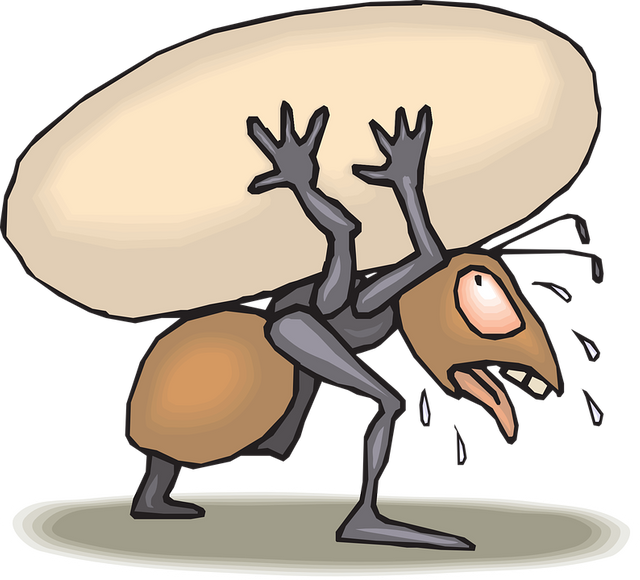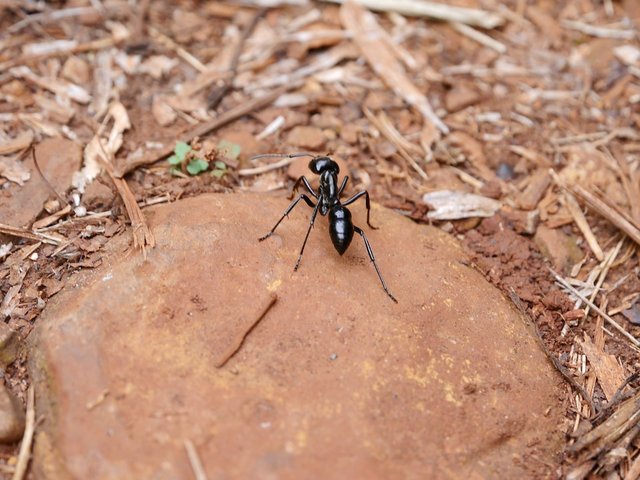Not so busy ants and the Pareto principle
This weekend, I went through the chapter called Ants at work: maids, nannies, laborers, soldiers in the book by Jae Choe that I have mentioned in previous posts.
Here, the text explains how ants work as maids, nannies, laborers, and soldiers in the colony. (I know you guessed that.) In fact, the writer goes on to assert that the only human occupations of which he has not found parallels in the ant world are the clergy and professorship.
Now you may say that ants certainly do not have computer programmers or bloggers in their nests. I agree, but I would try to believe Jae Choe and consider the generalized versions of these occupations so that messenger ants that spread information (using chemicals, sounds, dances) become our reporters and bloggers. The level of abstraction involved in computer programming is a little tricky to generalize, and we will probably need to get back to the author about this.
So we now know that ants do not have universities, religions, and computers. I will have to devote a post (or several posts) on the division of labor in the colony and on the occupational adventures of ants, but this post is about how ants seem to spend most of their time not working, so I will focus on that for a while.

Who has time for a picnic? Ants may look busy but looks can be misleading
Source: pixabay
Not so busy ants
Seeing the frantic movement of ants everywhere, you may have come to the conclusion that ants are busy creatures. In fact, we do say “busy as an ant,” and we create comics like this one.
If you did not click on that link, it shows an image of ants on a picnic blanket with text that proclaims that ants may be busy but they always find time for a picnic.
I don’t know about you, but I don’t always find time for a picnic. So I was intrigued to learn that worker ants spend only about 20% of their time working, and the rest of their day is spent “sitting around, doing nothing.” Jae Choe himself speaks of the experiment on which he timed the work hours, and mentions that this fits in well with the Pareto principle.
What is the Pareto principle?
This principle, also known as the 80/20 rule, originated with Vilfredo Pareto’s finding that 80% of the land in Italy was owned by 20% of the population in 1896. He then went on to show that 20% of the peapods in his garden produced 80% of the peas. This second example alone shows that the 80/20 rule can be applied to a wide array of cause and effect scenarios. This possibility for broad generalization usually means that we should be very careful in applying it to cause and effect scenarios.
An opinion article in The Guardian talks about how this law can be applied to everything from vocabulary usage (20% of words in 80% of usage) to internet traffic (80% of users flock to 20% of websites). It also delves into the mathematics of the power law distribution, and eventually comes to the conclusion that increasing taxes for the super rich does sound like a good idea.
On the other hand, since we have to be careful with broadly applicable laws, this blog post goes on to show why the Pareto law does not always work, with demonstrations using data on the writer's productivity and income sources.
So the point is the Pareto law works for many things, but not all things.
What has this got to do with ants?
This came up because I came across the term while reading about the fact that ants seem to work only 20% of the time. The plot thickens a little bit more, because the author also mentions that about 80% of the workers will be sitting in the nest and doing nothing at any given moment. He then proceeds to hypothesize that the inactive ants are probably reserve workforce waiting to get out and do stuff if they are needed.
As a parallel example, he mentions that human beings have been known to leave their work to go and help others in times of disasters (earthquakes, hurricanes, etc.), and ants have also probably evolved to maintain a reserve workforce because of all the disasters they have had to go through.

I’m a little late for my daily nap.
Source: pixabay
Recent scholarship on ant laziness
In 2015, Daniel Charbonneau and Anna Dornhaus from the University of Arizona published an article on inactive ants. They reported that some ants in a colony were “specialized to be inactive” and never seemed to work at all. A sciencemag article shows these numbers in an easy to understand infographic: 3% of the ants were always working, 25% were never working, and 72% were inactive almost half of the time.
Why this inefficiency?
Now if you are thinking that all this unused labor is a waste, we will have to talk about a more recent article that Daniel Charbonneau’s team published last month.
In order to see exactly what was going on in the nest, the scientists first applied paint dots on the ants such that individuals could be identified. If you would like to look at cute painted ants, you can look at a picture and also read a piece about the whole experiment here.
The painted ants acted as ants always do, and they divided themselves into the active working group and the inactive resting group. Then the researchers first removed some active ants from the colony. Within a week, inactive ants had started working in place of the lost workforce such that the activity level remained constant. The researchers then proceeded to remove some inactive ants and waited to see if some active ants would replace them and start taking rest. That did not happen. This establishes that the inactive ants are not being lazy. They are the reserve workforce of the colony, and they will promptly start working if it becomes necessary.
Higher perspective
If we look at the colony as a superorganism such that an individual ant is simply an “organ” working for the survival of the superorganism, this does make sense. The colony might be more productive if all the workers go out there and collect food all the time, but if a disaster falls upon all of them, the superorganism dies. If disaster falls upon the 20% of the ants that are active at a given time, the superorganism loses some workers and it might be weaker for a while but it still lives and it can “regenerate” the lost ants with time.
What is the conclusion?
The conclusion is that ants may not be as busy as they appear to be, but they are certainly wise. Well, the colony is certainly wise.
Thank you for reading. And do let me know your thoughts in the comments.
Links to references and image sources are provided in the text.
This post was resteemed by @steemitrobot!
Good Luck!
The @steemitrobot users are a small but growing community.
Check out the other resteemed posts in steemitrobot's feed.
Some of them are truly great. Please upvote this comment for helping me grow.
Thanks, was not aware about this, but this established redundancy for sure helps the colony surviving disasters like heavy rains or other instances, where an ample amount of outside workers gets killed. Without the spare troops the survival chance of the colony would be much lower. Plus the reserve can also quickly be engaged to transport the precious eggs to a saver place in an emergency case.
Yes, the inactive ants seem to save the colony from a catastrophic destruction. Thanks for reading.
Very interesting article. Now that I know the number of ants I see scurrying around is a whole lot less than what is in that underground ant colony I am sufficiently creeped out.
Well, I don't think they are planning to take over the world anytime soon, so I think we can just marvel at the fact for now. Thank you for reading!
Wow, that is surely unheard of. I always thought that all ants keep working, except the queen ant!! And this Pareto principle is also very interesting concept.
Yes, they seem busy all the time, but then, the ones that are not busy are staying in their nests and we never get to see them. Thank you for reading!
Great read! Followed and upvoted :) keep up the good work
Thank you.
I think it also goes to say that those inactive ants aren't simply a draw on ant society. They have a purpose (unlike nonparticipants in other types of societies ;-D).
Are you saying that the unemployed or the jobless rebels are a draw on human society? I think there are others that do much more harm to our world than the inactive population, and I worry much less about the nonparticipants than I do about the deluded participants. Thanks for reading!
I agree to a certain percent but I also think that a lot of more localized problems are solved when people are busy with something productive. Bored people find things to do that are often very counter productive. No one does just 'nothing'. Everyone lives up to their ability to contribute. If they aren't contributing in a positive way they often look for ways to subvert the system. This can cause huge problems and a ripple effect for all those in affected areas. I understand that this is one premise behind city areas where it is unsafe for residents and where large populations are pulled into a cycle of poverty.
There are, admittedly many social and economic contributors but one stated often is that there is 'nothing else for young people to do' but become part of the problem.
I do agree with you that those people who feel a need to have rules and laws for every tiny detail of life can often miss the point that their solution doesn't work for everyone and it can make more trouble than it helps. This is particularly true when they start doing it in the political arena.
Speaking only of the ants, it's an interesting post and I believe that it's conclusions also apply to research done on bees, another highly socialized insect society. Biologists like to study bees as opposed to ants and it's there's something very satisfying in our understanding of the world when research shows strong parallels.